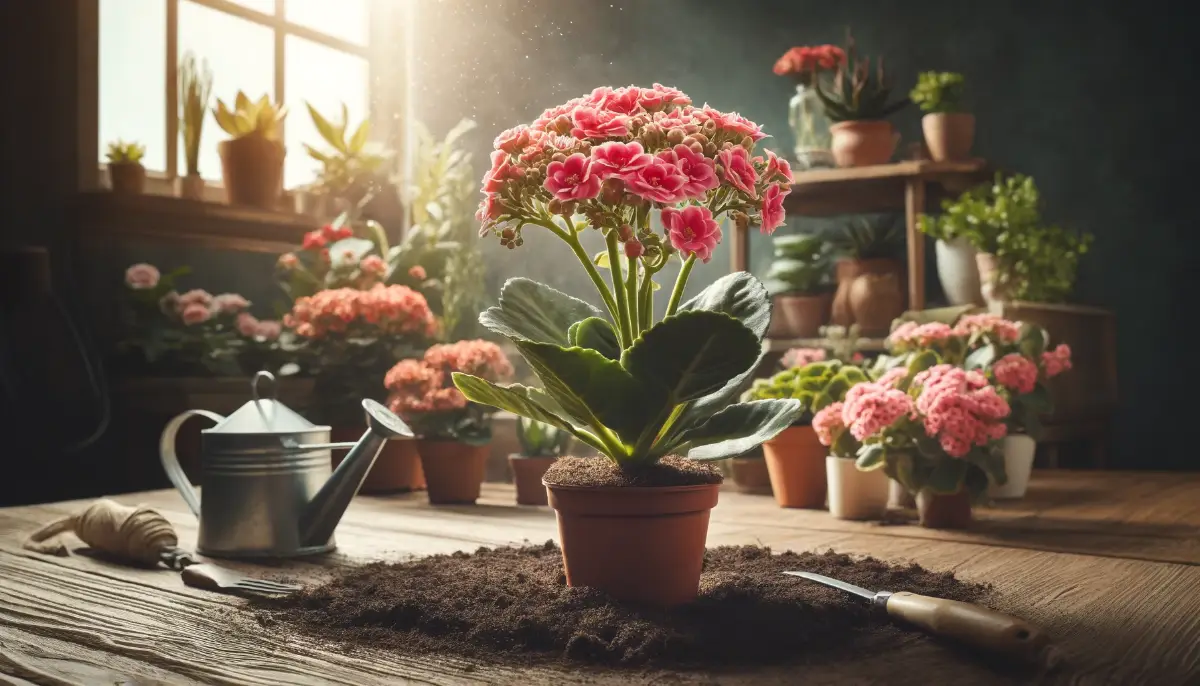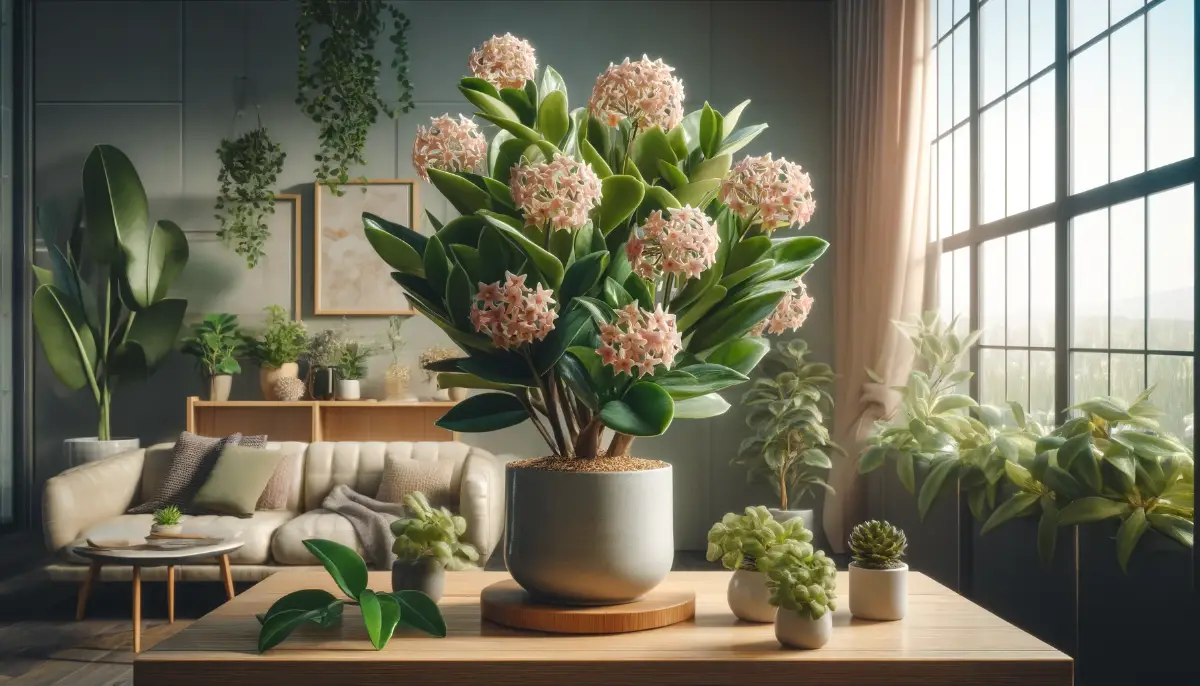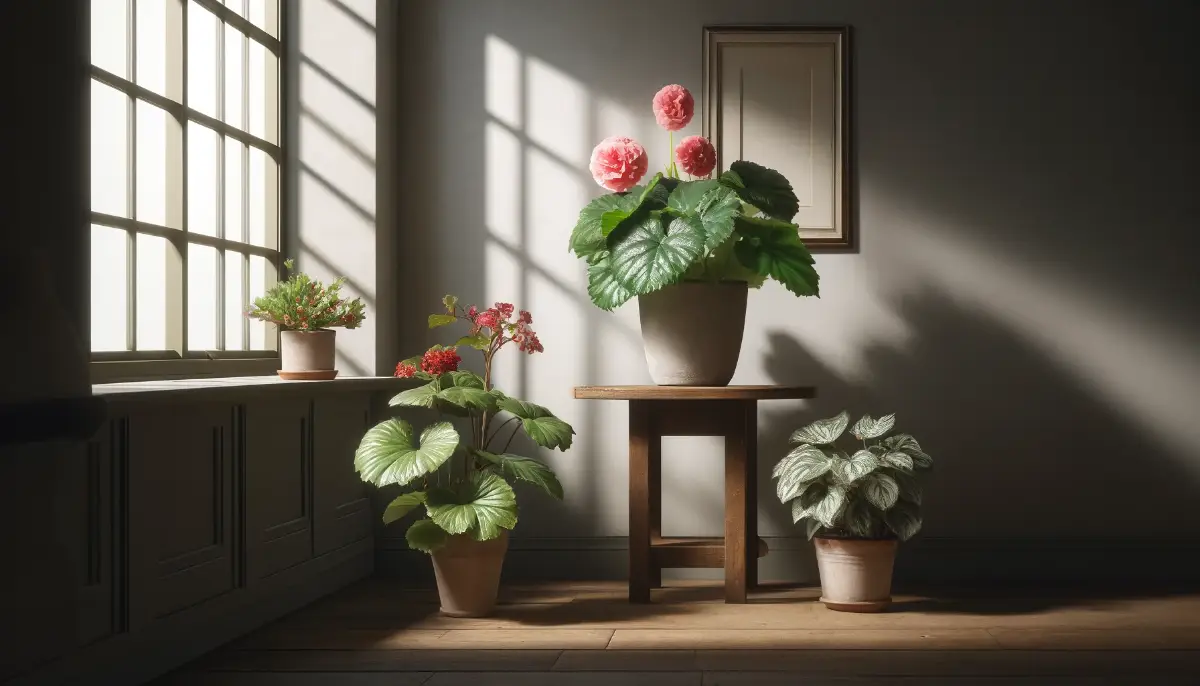Kalanchoe, a delightful succulent known for its vibrant blooms and resilient nature, offers a burst of color and life to any indoor garden setting. This low-maintenance plant is an excellent choice for both novice and seasoned plant enthusiasts.
Thriving in well-draining soil and bright, indirect sunlight, Kalanchoe demands minimal care, making it a popular choice for those who may not always remember to water their plants regularly.
In this guide, we’ll explore how to maximize your Kalanchoe’s potential, ensuring it provides a long-lasting display of its colorful flowers.
- Kalanchoe thrives in bright, indirect sunlight and requires well-draining soil.
- It’s essential to let the soil dry out between waterings to prevent root rot.
- Fertilizing is beneficial during the growing season but should be reduced or stopped in the dormant winter months.
Optimal Growing Conditions
Kalanchoe thrives in an environment that replicates its native habitat, which is characterized by bright but indirect sunlight and moderate temperatures. Ideal growing conditions for Kalanchoe include:
- Light: Kalanchoe requires plenty of bright, indirect sunlight. Direct exposure to harsh sunlight can scorch the leaves, while insufficient light can cause the plant to become leggy.
- Temperature: The optimal temperature range for Kalanchoe is between 60 and 85°F. It’s crucial to protect the plant from frost, as it is not frost-tolerant. Kalanchoe can adapt to varying indoor temperatures, making it suitable for most homes.
- Humidity: Kalanchoe does well in environments with low to moderate humidity. As a succulent, it doesn’t require high humidity levels and can tolerate the dry conditions found in many homes.
For those looking to ensure their Kalanchoe not only survives but thrives, it’s important to provide a living situation that best mimics these conditions. This includes placing the plant in a location where it can receive the right amount of light without being exposed to extremes and monitoring the surrounding temperature and humidity to ensure they remain within the ideal range.
Watering your Kalanchoe
Watering your Kalanchoe correctly is crucial for its health and longevity. Here’s how to do it properly:
- Dry Soil Requirement: Kalanchoe plants require the soil to dry out completely between waterings. Overwatering can lead to root rot, a common issue with succulents that can be fatal.
- Watering Depth: When you do water, ensure you moisten the soil deeply. This encourages the roots to grow deeper, promoting healthier plants. Always check that the top inch or two of the soil is dry before adding more water.
- Seasonal Adjustments: During winter, Kalanchoe’s watering needs decrease significantly. The plant enters a dormant period where less water is needed, so reduce the frequency of watering during these cooler, darker months.
Feeding your Kalanchoe
Feeding your Kalanchoe organically involves using natural fertilizers that are gentle on the plant and beneficial for the soil. Here are some organic feeding tips for maintaining a healthy Kalanchoe:
Organic Fertilizer Options:
- Compost: Incorporate a small amount of compost into the soil. Compost provides a slow-release of nutrients, which is ideal for Kalanchoe.
- Worm Castings: These are another excellent organic option that can be mixed into the potting soil to improve nutrient content and soil structure.
- Fish Emulsion: This is a fast-acting organic fertilizer that provides a nitrogen boost. Dilute it well and use it sparingly, as too much nitrogen can harm the delicate balance needed for succulents.
Application Frequency:
- During the growing season (spring and summer), apply organic fertilizers once per month. Kalanchoe doesn’t require heavy feeding, so a light application is sufficient.
- Reduce feeding during the dormant winter months since the plant’s growth slows down and it requires fewer nutrients.
Benefits of Organic Feeding:
- Soil Health: Organic fertilizers improve the overall health of the soil by enhancing its structure and increasing its ability to hold water and nutrients.
- Plant Health: They provide a balanced supply of nutrients, which helps prevent nutrient burn and supports steady, healthy growth.
- Environmentally Friendly: Using organic fertilizers reduces the risk of chemical run-off, making it a more environmentally sustainable choice.
Feeding your Kalanchoe with organic fertilizers not only supports its growth but also contributes to a more sustainable gardening practice. Always ensure that any fertilizer used is well-diluted and applied according to specific guidelines to avoid over-fertilization, which can be detrimental to your plant.
Soil and Repotting for Kalanchoe
Proper soil and repotting practices are essential for the health and longevity of your Kalanchoe plants. Here’s how to ensure the best conditions:
Soil Requirements
- Well-Draining Medium: Kalanchoe requires well-draining soil to prevent waterlogging and root rot, common issues in succulents. A mix specifically formulated for cacti and succulents, which typically contains sand, perlite, and peat, is ideal.
- DIY Soil Mix: For a more customized approach, you can create a homemade mix using 60% peat and 40% perlite. This mixture ensures good drainage and aeration, promoting healthy root growth.
Repotting Kalanchoe
- Timing: Kalanchoe should be repotted every two to three years or when it outgrows its current pot. The best time to repot is in the spring, just before the growth season begins.
- Pot Selection: Choose a pot that is slightly larger than the current one, ensuring it has adequate drainage holes. Avoid selecting a pot that is too large as it can lead to excess soil moisture, which is detrimental to the plant’s roots.
Repotting Steps:
- Preparation: Before repotting, water your Kalanchoe a few days in advance to moisten the soil, making it easier to remove the plant.
- Removing the Plant: Gently remove the plant from its pot, being careful not to damage the root system.
- Root Inspection: Trim off any dead or rotted roots and loosen the root ball slightly to encourage new growth.
- Backfilling: Place the plant in the new pot and backfill with fresh potting mix, pressing down lightly to eliminate any air pockets.
Pruning and Maintenance of Kalanchoe
Proper pruning and regular maintenance are key to keeping your Kalanchoe healthy and attractive. Here’s how you can effectively care for your plant:
Pruning Kalanchoe
- Timing: Pruning is best done after the flowering period or in early spring before the new growth begins.
- Method: Kalanchoe plants don’t need heavy pruning, but pinching off the tips of leggy stems can encourage a fuller, bushier growth. This process, known as “pinching back,” involves removing the growing tip of a stem to promote the growth of lateral branches.
- Flower Maintenance: Once the flowers fade, deadhead them to promote more blooms and to keep your plant looking tidy. This involves snipping off the spent flower heads, which can prevent the plant from expending energy on seed production.
General Maintenance
- Cleaning: Wipe the leaves with a damp cloth periodically to remove dust. This not only keeps the plant looking fresh but also improves its ability to photosynthesize more efficiently.
- Inspection: Regularly inspect your Kalanchoe for signs of pests or diseases. Common issues include mealybugs and aphids, especially on outdoor plants. A light spray of insecticidal soap can help manage these pests.
- Soil Check: Ensure that the soil is well-draining and not becoming compacted. Over time, soil in containers can become dense, which can affect drainage and root health. Loosening the soil gently with a fork can help improve aeration.
Maintaining these practices will help ensure that your Kalanchoe remains healthy, vibrant, and blooms beautifully.
Propagation Techniques for Kalanchoe
Kalanchoe plants are relatively easy to propagate, offering a rewarding way to expand your collection or share with friends. Here are some of the most common methods:
Propagation from Cuttings
- Stem Cuttings: This is the simplest method. Take a cutting of about 2-3 inches from a healthy Kalanchoe stem just above a leaf node. Remove the lower leaves and let the cutting dry for a day or two to form a callus, which helps prevent rotting when planted.
- Leaf Cuttings: Kalanchoe can also be propagated from leaves, though this method might take longer. Pluck a healthy leaf and allow it to callus in the same manner as stem cuttings. Once callused, place it on well-draining soil, and it will eventually develop roots and new shoots.
Propagation by Offsets
- Offsets: Some Kalanchoe species produce small offsets that can be carefully removed and planted separately. These are small clones that grow at the base of the parent plant and are a natural way to propagate the species.
- Care for Offsets: Once separated, allow the offsets to dry for a day or two to callus. Then, pot them in a suitable succulent mix and water sparingly until roots are established.
Seed Propagation
- Seeds: While less common due to the availability of easier methods, Kalanchoe can be propagated from seeds. If you have access to seeds, they can be sown in a light seed-starting mix and kept moist until germination occurs. This method requires patience and careful attention to moisture and temperature.
By using these techniques, you can effectively propagate Kalanchoe, expanding your garden with new plants that inherit the parent’s characteristics. Each method has its own set of steps and care requirements, but all can yield healthy, robust plants if done correctly.
Addressing Common Problems in Kalanchoe Care
Kalanchoe plants are generally robust and low-maintenance, but they can encounter a few common issues, particularly related to watering, pests, and light conditions. Here’s how to diagnose and address these problems:
Overwatering and Root Rot
- Signs: Yellowing leaves, soft and mushy stems or leaves, and a damp, musty smell are indicative of overwatering and potential root rot.
- Solution: Reduce watering immediately. Allow the soil to dry out completely between waterings, and ensure the pot has good drainage. If root rot is suspected, repot the plant into fresh, dry soil after removing any rotted roots.
Pests
- Common Pests: Mealybugs, aphids, and occasionally scale can affect Kalanchoe.
- Signs: Sticky residue on leaves or the presence of tiny bugs on the undersides of the leaves.
- Solution: Treat the plant with a neem oil spray or insecticidal soap. For mild infestations, wiping the leaves with alcohol can remove pests.
Insufficient Light
- Signs: Leggy growth, with long stems and sparse leaves, indicates insufficient light.
- Solution: Move the Kalanchoe to a brighter location where it receives bright, indirect sunlight. If moving the plant is not possible, consider using a grow light to supplement the natural light.
Nutrient Deficiency
- Signs: Slow growth, pale or yellowing leaves can indicate a lack of nutrients.
- Solution: Fertilize the plant during the growing season with a balanced, water-soluble fertilizer once a month. Ensure not to over-fertilize, as this can lead to salt build-up in the soil.
By keeping an eye out for these signs and addressing issues promptly, you can keep your Kalanchoe healthy and vibrant. Regular maintenance and adjustments to care routines can often prevent these problems from becoming serious.
FAQs about Kalanchoe Care
How often should I water my Kalanchoe?
Water your Kalanchoe only when the top inch or two of soil feels dry to the touch. During winter, reduce watering frequency as the plant enters a dormant phase.
Does Kalanchoe need direct sunlight?
Kalanchoe thrives in bright, indirect sunlight. Direct sunlight can scorch the leaves, so it’s best to place it in a spot where it will receive filtered light.
What is the best soil for Kalanchoe?
Use a well-draining soil mix, ideally formulated for cacti and succulents. A mix containing peat, perlite, and sand is suitable for ensuring proper drainage.
How do I get my Kalanchoe to bloom again?
To encourage blooming, provide shorter daylight hours for about six weeks. This can be achieved by placing it in a dark room or covering it to simulate shorter days. Resume regular light exposure once buds appear.
Can I grow Kalanchoe outdoors?
Yes, Kalanchoe can grow outdoors, where frost is not a concern. Ensure it’s placed in a location that receives bright, indirect light and is protected from extreme temperatures.
How do I propagate Kalanchoe?
Propagate Kalanchoe from stem or leaf cuttings. Allow the cuttings to callous for a few days before placing them in well-draining soil.
What common pests affect Kalanchoe?
Kalanchoe can be susceptible to mealybugs and aphids. Treat infestations with insecticidal soap or neem oil, and keep the leaves clean to discourage pests.
How often should I fertilize my Kalanchoe?
Fertilize your Kalanchoe monthly during the spring and summer with a balanced, water-soluble fertilizer. Reduce feeding in the fall and winter when the plant’s growth slows.
Why are my Kalanchoe’s leaves turning yellow?
Yellow leaves can be a sign of overwatering or poor drainage. Ensure the pot has drainage holes and the soil is not waterlogged. Adjust your watering schedule accordingly.
Can I use tap water to water my Kalanchoe?
Yes, you can use tap water, but if your water is highly mineralized, it might be better to use distilled or rainwater to avoid salt buildup, which can harm the plant.









